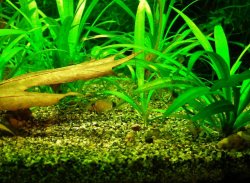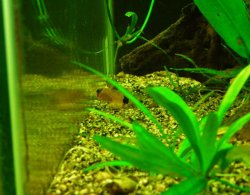Pandas do seem easier to spawn. They are being commercially raised, not wild caught, and have been for a decade or so I believe, which is not the norm with cory species. Of the more than 150 species, I don't think there are more than four or five being commercially spawned.
I have a group of five, and I know they are spawning because just two weeks ago I recovered a panda cory fry when I was last cleaning the canister on this tank, which is my largest (5-foot, 115g). I just took a couple photos of the fellow, he is about twice the size now, and loves chomping into shrimp pellets. The leaves are important in fry tanks for the infusoria, and I see him grazing the dried oak leaves regularly so presumably this is providing good nourishment.
First thing is, how many you have, and are there male and female. I'll leave that for you to deal with.
It is difficult to obtain any eggs/fry in display tanks with other fish because these often eat the eggs as soon as they are laid. My cory fry have all been rescues from the filter, and several species do spawn in this tank (there are 40 or so corys, in various numbers representing 12+ species). One problem I see with your tank is the pleco. Even primarily vegetarian loricariids will get eggs/fry, but the L144 species is primarily carnivorous, and active night and day. You will likely have to move the pandas to a small tank for spawning, or remove the pleco. The Boraras brigittae are not likely to eat cory eggs or fry. The pandas themselves may or may not eat eggs if they find them, I don't know how many you have. My pygmy corys are in the 10g, and I just leave them alone and eggs and fry are regularly showing up and a number of fry survive; but pygmy corys are considerably smaller.
The eggs will be placed individually here and there on surfaces, so spawning mops are pointless with corys. Plant leaves, especially the underside, the glass tank walls, filter stems, are all normally selected by the fish. I have never seen the eggs in the big tank, just the fry that survive, but in the 10g the pygmies place the eggs in Java Moss (but individually, a couple or so each spawning), on dried oak leaves, plant leaves, and the tank walls.
Conditioning the corys can be important. A major water change with slightly cooler water, especially if carried out on a day when a low pressure system is approaching or present, usually works. I'm not trying to get mine to spawn, but I do see increased interaction during low pressure days and after most water changes. Good quality prepared sinking foods should be sufficient; I would be careful of feeding bloodworms too much, mine get them once a week. They are high in fat and not especially nourishing nutrient-wise.
Food for the fry is probably the trickiest aspect. Dried leaves like oak, beech, Indian almond are excellent and now known to increase the growth rate of most any fry. I have a couple dozen in my 10g. If the tank is established, live foods will be present all over the place, around wood, on plants. You can buy fry foods. I think Akasha has gone down this road, so if she sees this she will certainly chip in.
Byron.




